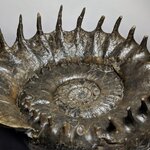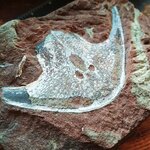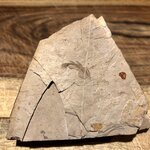Paleontology

Take a gander at this unusual trilobite, Hypodicranotus striatulus (Walcott, 1875), with his gloriously bulbous head shield. Missing from this specimen is the wonderful forked hypostome from the dorsal exoskeleton that marks him as H. striatulus. He’s from outcrops in the Verulam Formation, Bowmanville, Ontario, Canada. He lived in a deep subtidal environment as a nektobenthic deposit feeder some 460.9 to 449.5 million years ago.
These extinct pelagic trilobites are in the order Asaphida in the family Remopleuridae. Specimens have been found in Middle Ordovician marine…

During the early Triassic period, ichthyosaurs evolved from a group of unidentified land reptiles that returned to the sea. They were particularly abundant in the later Triassic and early Jurassic periods before being replaced as premier aquatic predator by another marine reptilian group, the Plesiosauria, in the later Jurassic and Cretaceous periods.
In the Late Cretaceous, ichthyosaurs were hard hit by the Cenomanian-Turonian anoxic event (OAE 2). The OAE 2 occurred approximately 93.9 ± 1.5 million years ago. We see evidence of a carbon cycle, oxygen and sulfur cycle disturbance in the…

Baleen whales (mysticetes) lack teeth as adults and instead filter feed using keratinous baleen plates. Balaenids are distinguished by their thick blubber and enlarged heads and form a parvorder of the infraorder cetacea -- whales, porpoises and dolphins. They do not echolocate with ultrasonic frequencies like toothed whales but are instead known for infrasonic acoustics. (a) Figured Above: Photograph of holotype skull of B. osedax (USNM 539939) in dorsal view; (b) line art superimposed on 3D model of holotype skull with colour to distinguish bones.Both baleen and infrasonic…

These ammonites are from the Arnioceras beds near Last Creek, British Columbia. The fossils found here are from the Lower Jurassic, Lower Sinemurian, Little Paradise Member of the Last Creek formation. This site is part of the research area for Dr. Howard Tipper, GSC (who is hugely missed) and Dr. Louise Longridge, University of British Columbia. Several ammonites species can be found here including Arnioceras semicostatum&Arnioceras miserable.
Building on the work of Dr. Howard Tipper and Dr. Louise Longridge, along with Taylor et al from 2001, Pengfei Hou did a Master's thesis through…

Previously Calycoceras Tarrantense, this ammonite is now Conlinoceras tarrantense after J.P. Conlin, a famous early 20th century Texas fossil collector. Ammonite expert Bill Cobban used this collection to describe many Texas Cretaceous ammonites species including this species from Tarrant County, Arlington, Texas. He was a surveyor by training and kept incredibly detailed notes on the context of his fossils.
Much of his collection was donated to the United States Geological Survey and we’ve learned much by studying it along with other specimens from the Lone Star State. Almost a quarter of…

This stunning specimen with her regal ridges (and small anomaly) is an Apoderoceras ammonite, an extinct genus of cephalopod and active predatory mollusk belonging to the subclass Ammonoidea.
Apoderoceras is a wonderful example of sexual dimorphism within ammonites as the macroconch (female) shell grew to diameters in excess of 40 cm – many times larger than the diameters of the microconch (male) shell. Apoderoceras has been found in the Lower Jurassic of Argentina, Hungary, Italy, Portugal, and most of North-West and central Europe, including as this one is, the United Kingdom. This…

An armored agnatha jawless bony fish, Victoraspis longicornualis, from Lower Devonian deposits of Podolia, Ukraine. Victoraspis longicornualis was named by Anders Carlsson and Henning Bloom back in 2008. The new osteostracan genus and species was described based on material from Rakovets' present day Ukraine. This new taxa shares characteristics with the two genera Stensiopelta (Denison, 1951) and Zychaspis (Javier, 1985). Phylogenetic analysis supports the position of Victoraspis as the sister group to the monophyletic, Stensiopelta.
The Agnatha are a superclass of vertebrates. He looks…

The McAbee fossil beds are known for their incredible abundance, diversity and quality of fossils including lovely plant, insect and fish species that lived in an old lake bed setting 52 million years ago.It is one of the best local sites in the province to experience a fossil dig first-hand. It's an easy 4 hour drive from Vancouver and easily done as a daytrip. The site was designated a Provincial Heritage Site under British Columbia's Heritage Conservation Act back in July of 2012, then promptly closed to the public.
It's recently been reopened to public collecting (as of June 21, 2019),…

This beautiful specimen is Protoaster Haefneri, a new species of edrioasteroid, an extinct lower Cambrian genus of echinoderm from the Kinzers Formation of York County, Pennsylvania. The specimen was found by and named after Chris Haefner, and is set to be "unveiled" this September at a conference in Moscow, Russia. This is one of only two specimens of this new lower Cambrian genus of echinoderm found in the 520 million years shales of the Kinzers. The specimens were collected during field work in 2017 and 2018, and form the basis of the research to be published this Fall by Dr.…

Coahuilaceratops or "Coahuila Horn Face," is a relatively new genus of Ornithischia Ceratopsidae, a herbivorous ceratopsian dinosaur who lived during the Upper Cretaceous (late Campanian) near the town of Porvenir de Jalpa (about 64 km / 40 miles west of Saltillo) in what is now southern Coahuila (formerly Coahuila de Zaragoza), northern Mexico.
The Sierra Madre Oriental mountain range runs northwest to southwest forming a spine through the centre of the State. East of the range, the arid landscape slopes gently through desert terrain down to the Rio Grande. It is home to wonderful…